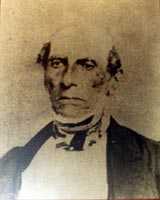Henri Castro
| Henri Castro | |
|---|---|
 | |
| Born |
July 1786 Landes, France |
| Died |
November 3, 1865 (aged 79) Monterrey, Nuevo León |
Resting place |
St. Louis Cemetery Castroville, Texas |
| Ethnicity | Jewish, Portuguese |
| Known for | Empresario colonization of Republic of Texas |
| Religion | Jewish |
| Spouse(s) | Amelia Mathias |
Henri Castro (1786 – November 3, 1865), a Jewish Texan, was one of the most important empresarios of the Republic of Texas.
Early life
Castro, who was born in Bayonne, France, was a French diplomat of Portuguese-Jewish descent. He later immigrated to the United States and became an American citizen in 1827. In 1838, he worked as a banker in France and sought to secure a loan for the young Republic of Texas. He was then appointed as consul general for Texas by President Sam Houston. He recruited hundreds of families for emigration to Texas. Most came primarily from the Haut-Rhin region of Alsace, in northeastern France. They traveled to Texas from 1843 to 1847 and settled in the Medina River valley, just west of San Antonio. The city of Castroville on the Medina River is named for him, as is Castro County in the Texas Panhandle. Castro himself settled for a time in Castroville.
Republic of Texas land grants
The Republic of Texas issued colonization land grants with individuals, conditional upon said individuals establishing settlements in a stated geographical area of Texas. The grants were limited to a given time period in which the colonization had to take place.[1]
On February 15, 1842, Castro, in temporary partnership with Jean Jassaud, was issued two land grants by the Republic of Texas. The grants were for the colonization of 600 families (with an option to increase that number to 1000) in three years. The first 200 families had to be settled by August 15, 1843.[2] One grant was approximately 600,000 acres, near what is now Starr County, along the Rio Grande. Castro would not be successful in fulfilling the colonization of this grant. The other grant totaled 1,250,000 acres, west of San Antonio and included the counties of Atascosa, Frio, La Salle, Medina and McMullen. This second grant would result in what came to be known as Castro's Colony.[3]
Castro began recruiting from an office in Paris in 1842 and the first of his recruits sailed into the port of Galveston, Texas on January 1, 1843. In the fall of 1843, Castro recruits in Alsace, Baden and Switzerland. Waves of his colonists depart for Texas in the winter of 1843 and spring of 1844. Castro left Europe for Texas on May 19, 1844 by way of New Orleans. He made it to San Antonio in July 1844 to meet with the colonists and was escorted by the Texas Rangers to inspect his land grant. The first of Castro's colonists arrive at the land on September 2, 1844.[4]
A grant covering 3,878,000 acres over 5,000 square miles, went to Henry Francis Fisher and Burchard Miller. On June 7, 1842, Fisher[5] and Miller[6] received a colonization land grant to settle 1,000 immigrant families of German, Dutch, Swiss, Danish, Swedish, and Norwegian ancestry. The grant was issued as the Fisher-Miller Land Grant. Fisher and Miller were also unsuccessful in colonization efforts, but they were able to get their deadline extended. On June 26, 1844, they sold the grant to the Adelsverein. Henry Fisher was made part of the Verein colonial committee.On July 3 and July 6, 1842, two land grants were issued to Alexander Bourgeois d'Orvanne and Armand Ducos, for colonization of 1,700 families along the Uvalde, Frio and Medina rivers.[7][8] On April 7, 1844, after their colonization efforts proved fruitless, Bourgeois and Ducos sold their grant to the Adelsverein, conditional on making Alexander Bourgeois d'Orvanne the Colonial Director. Unfortunately, the grant had already expired and Bourgeois was unable to get the deadline for colonization extended.
Additional sourcing
- Weaver PhD, Bobby D (2006). Castro's Colony: Empresario Development in Texas, 1842-1865. TAMU Press. ISBN 978-1-58544-518-9.
References
- ↑ Lang, Aldon S; Long, Christopher. "Land Grants". Handbook of Texas Online. Texas State Historical Association. Retrieved 20 February 2011.
- ↑ Ahr, Wayne M; Lagarde, Francois (2003). "Henri Castro and Castroville". The French in Texas: History, Migration, Culture. University of Texas Press. pp. 128–141. ISBN 978-0-292-70528-9.
- ↑ Bishop, Curtis. "Castro's Colony". Handbook of Texas Online. Texas State Historical Association. Retrieved 20 February 2011.
- ↑ Wolff, Linda (1999). Indianola and Matagorda Bay 1837 - 1887. Austin, Texas: Eakin Press. pp. 6–12. ISBN 1-57168-340-2.
- ↑ Biesele, Rudolph L. "Henry Francis Fisher". Handbook of Texas Online. Texas State Historical Association. Retrieved 20 February 2011.
- ↑ Biesele, Rudolph L. "Burchard Miller". Handbook of Texas Online. Texas State Historical Association. Retrieved 20 February 2011.
- ↑ Biesele, Rudolph L. "Armand Ducos". Handbook of Texas Online. Texas State Historical Association. Retrieved 20 February 2011.
- ↑ Biesele, Rudolph L. "Alexander Bourgeois d'Orvanne". Handbook of Texas Online. Texas State Historical Association. Retrieved 20 February 2011.
External links
- Henri Castro at Find a Grave
- Chapter 4: A History of the Castro Family from My Plan for Laredo by John Anthony Castro published 2005.
|